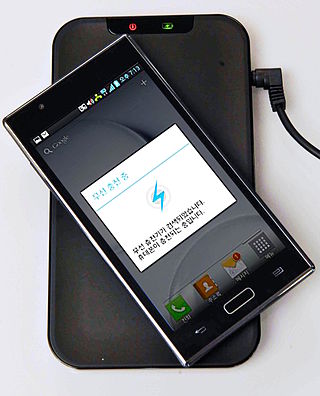
Wireless power transfer (WPT), wireless power transmission, wireless energy transmission (WET), or electromagnetic power transfer is the transmission of electrical energy without wires as a physical link. In a wireless power transmission system, an electrically powered transmitter device generates a time-varying electromagnetic field that transmits power across space to a receiver device; the receiver device extracts power from the field and supplies it to an electrical load. The technology of wireless power transmission can eliminate the use of the wires and batteries, thereby increasing the mobility, convenience, and safety of an electronic device for all users. Wireless power transfer is useful to power electrical devices where interconnecting wires are inconvenient, hazardous, or are not possible.
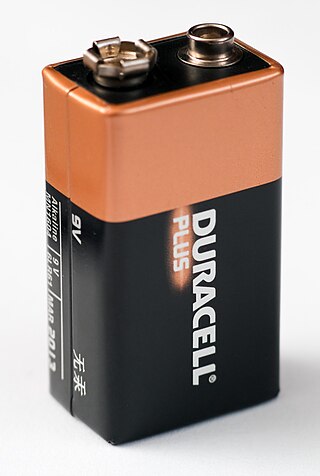
Duracell Inc. is an American manufacturer of alkaline batteries, specialty cells, and rechargeables; it is a wholly owned subsidiary of Berkshire Hathaway. The company has its origins in the 1920s, through the work of Samuel Ruben and Philip Mallory, and the formation of the P. R. Mallory Company.
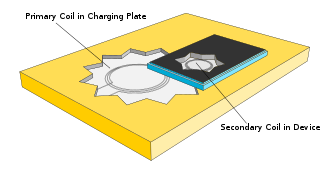
Inductive charging is a type of wireless power transfer. It uses electromagnetic induction to provide electricity to portable devices. Inductive charging is also used in vehicles, power tools, electric toothbrushes, and medical devices. The portable equipment can be placed near a charging station or inductive pad without needing to be precisely aligned or make electrical contact with a dock or plug.
WiTricity Corporation is an American wireless charging technology company based in Watertown, Massachusetts. The Massachusetts Institute of Technology (MIT) spin-off was founded by professor Marin Soljačić in 2007. WiTricity technology allows wireless power transfer over distance via magnetic resonance and the company licenses technology and reference designs for wireless electrical vehicle (EV) charging as well as consumer products such as laptops, mobile phones and televisions.
eCoupled is a proprietary near-field wireless energy transfer technology developed by Fulton Innovation, a division of Alticor. It provides wireless power transfer via inductive coupling between a primary transmission coil and a secondary receiving coil. A single primary coil can provide power to multiple secondary coils at the same time.

The Alliance For Wireless Power is an industry standard group that uses the principles of magnetic resonance to develop a wireless energy transfer system over distance. The WiPower system uses directed and controlled magnetic fields to replace traditional power cords. To do this, the transmitter utilizes one or more primary windings in order to induce an even magnetic field above its surface. A receiver in the magnetic field uses a secondary winding which captures the magnetic energy and converts it back to electrical energy.

Resonant inductive coupling or magnetic phase synchronous coupling is a phenomenon with inductive coupling in which the coupling becomes stronger when the "secondary" (load-bearing) side of the loosely coupled coil resonates. A resonant transformer of this type is often used in analog circuitry as a bandpass filter. Resonant inductive coupling is also used in wireless power systems for portable computers, phones, and vehicles.
The Wireless Power Consortium (WPC) is a multinational technology consortium formed on December 17, 2008, and based in Piscataway, New Jersey. Its mission is to create and promote wide market adoption of its interface standards Qi, Ki Cordless Kitchen, and Qi Medium Power for inductive charging. It is an open membership of Asian, European, and American companies, working toward the global standardization of wireless charging technology.
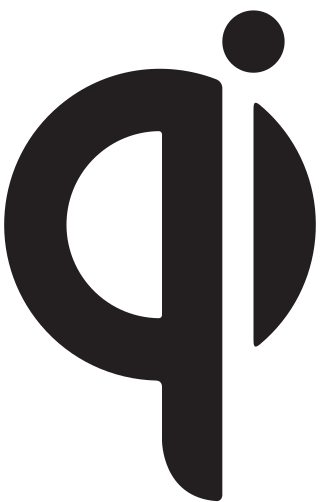
Qi is an interface standard for wireless power transfer using inductive charging. The standard allows compatible devices, such as smartphones, to charge their batteries when placed on a Qi charging pad, which can be effective over distances up to 4 cm.
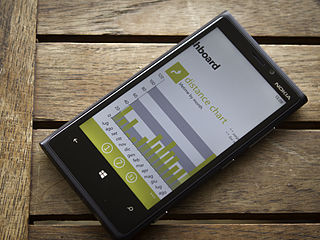
Nokia Lumia 920 is a smartphone developed by Nokia that runs the Windows Phone 8 operating system. It was announced on September 5, 2012, and was first released on November 2, 2012. It has a 1.5 GHz dual-core Qualcomm Krait CPU and a 4.5" IPS TFT LCD display, as well as a high-sensitivity capacitive touchscreen that can be used with gloves and fingernails; the display is covered by curved Gorilla Glass and has a 9 ms response time. The phone features an 8.7-megapixel PureView camera with OIS; it was the first smartphone camera to implement that technology, as well as to support Qi inductive charging. The phone comes with 32 GB of internal storage, but has no expandable storage.
The Nokia Lumia 822 is a smartphone running Windows Phone 8 announced on 29 October 2012. It is exclusively available for Verizon customers. The device is a variant of Nokia Lumia 820. The Lumia 822 supports Qi standard induction charging and LTE connectivity.

Power Matters Alliance (PMA) was a global, not-for-profit, industry organization whose mission was to advance a suite of standards and protocols for wireless power transfer for mobile electronic devices. The organization was merged with Alliance for Wireless Power (A4WP) in 2015 to form AirFuel Alliance.
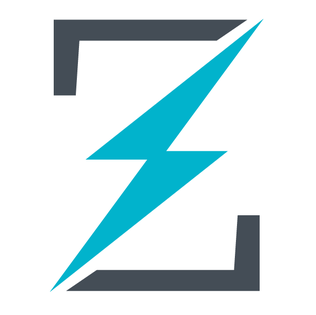
Rezence was an interface standard developed by the Alliance for Wireless Power (A4WP) for wireless electrical power transfer based on the principles of magnetic resonance. The Rezence system consisted of a single power transmitter unit (PTU) and one or more power receiver units (PRUs). The interface standard supported power transfer up to 50 watts, at distances up to 5 centimeters. The power transmission frequency is 6.78 MHz, and up to eight devices could be powered from a single PTU depending on transmitter and receiver geometry and power levels. A Bluetooth Low Energy link was defined in the A4WP system intended for control of power levels, identification of valid loads and protection of non-compliant devices.
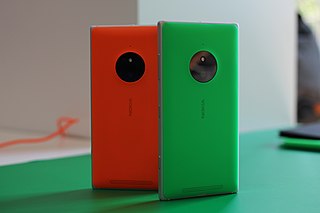
The Nokia Lumia 830 is a smartphone developed by Microsoft Mobile and branded as "Nokia" that runs Microsoft's Windows Phone 8.1 operating system. It was announced on September 4, 2014 at Internationale Funkausstellung Berlin and released in October 2014. It is a successor to the 2012 Nokia Lumia 820 and marketed as an "affordable flagship".
Ran Poliakine was an Israeli businessman who was the founder and CEO of Powermat Technologies. Poliakine was an entrepreneur, inventor and industrial designer.

The iPhone 8 and iPhone 8 Plus are smartphones designed, developed, and marketed by Apple Inc. They are the eleventh generation of the iPhone. The iPhone 8 was released on September 22, 2017, succeeding the iPhone 7 and iPhone 7 Plus respectively.

AirPower is an unreleased wireless charging mat developed by Apple Inc. It was designed to charge up to three devices simultaneously, supporting two Qi devices, such as an iPhone and AirPods, and an Apple Watch. It was announced on September 12, 2017. Formerly scheduled to be released in early 2018, AirPower failed to materialize, leading to wide speculation over the product's future, until Apple announced on March 29, 2019 that it had canceled the release.
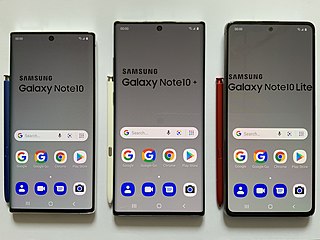
The Samsung Galaxy Note 10 is a line of Android-based phablets designed, developed, produced, and marketed by Samsung Electronics as part of the Samsung Galaxy Note series. They were unveiled on 7 August 2019, as the successors to the Samsung Galaxy Note 9. Details about the phablets were widely leaked in the months leading up to the phablets' announcement.

Huawei Mate 30 is a line of Android-based phablets manufactured by Huawei as part of its Huawei Mate series, and the successor to the Mate 20. The Mate 30 comprises the Mate 30/5G, Mate 30 Pro/5G, and Mate 30 RS Porsche Design, which were unveiled on 19 September 2019 in Munich, Germany.
SAE J2954 is a standard for wireless power transfer (WPT) for electric vehicles led by SAE International. It defines three classes of charging speed, WPT 1, 2 and 3, at a maximum of 3.7 kW, 7.7 kW and 11 kW, respectively. This makes it comparable to medium-speed wired charging standards like the common SAE J1772 system. A much more powerful WPT9 is being defined in J2954/2 for 500 kW charging for heavy-duty vehicles which have the room necessary to mount the larger induction plate.














